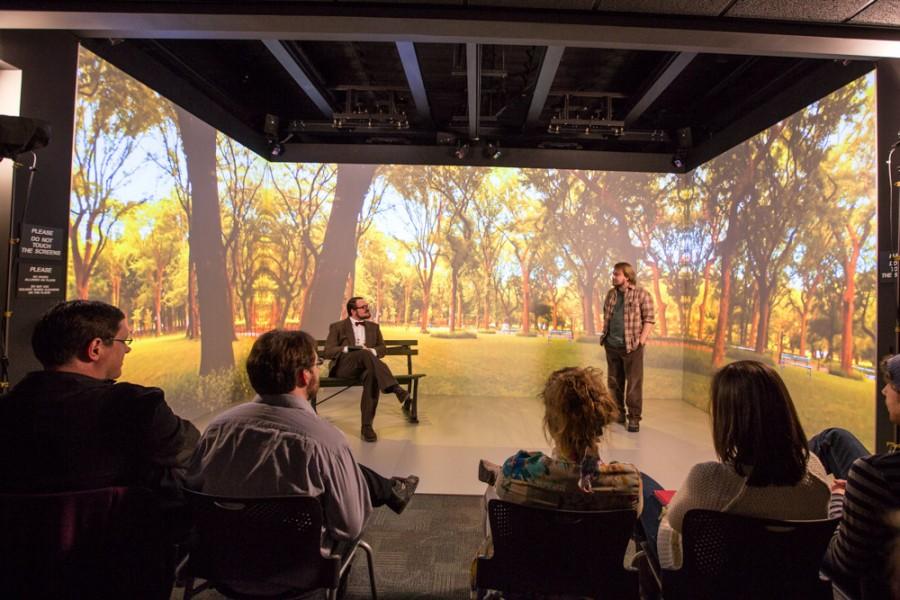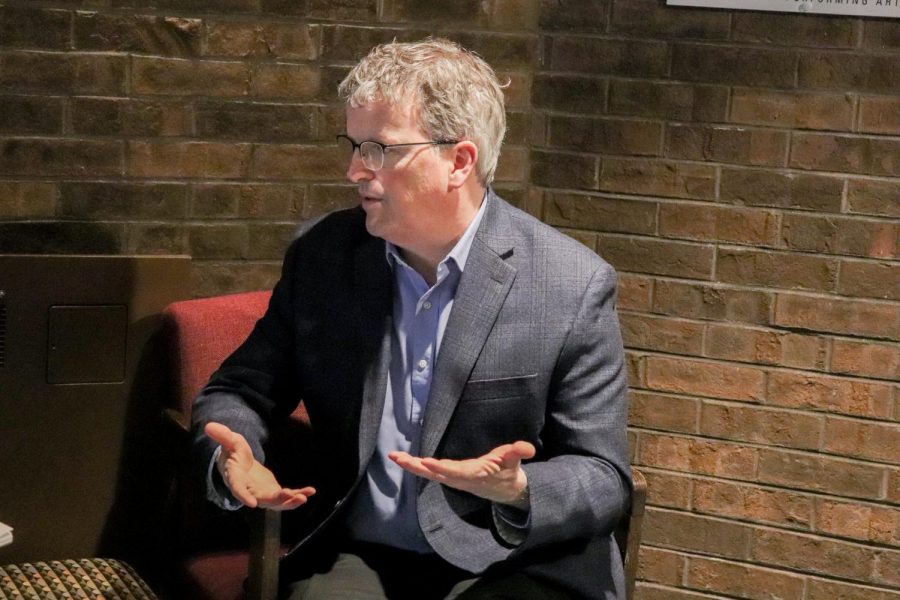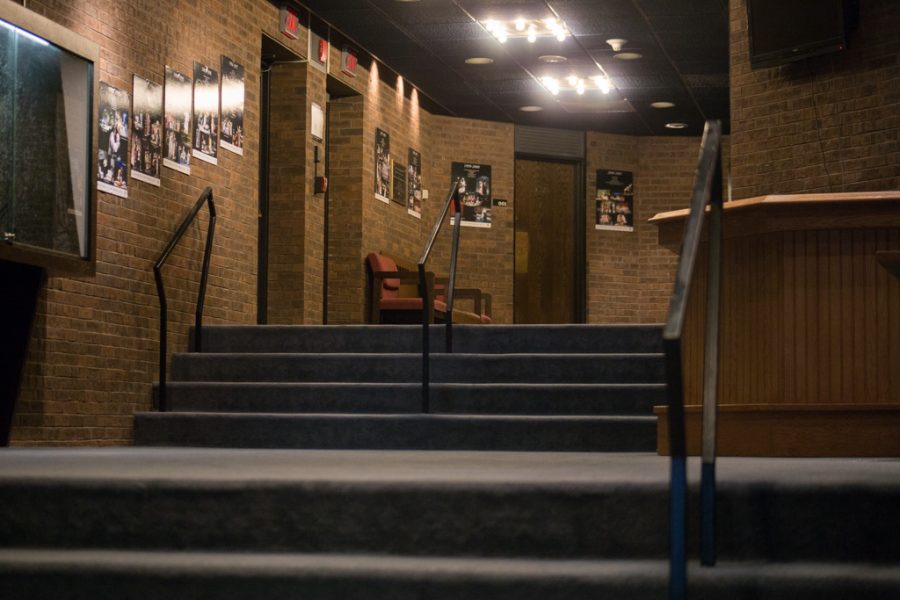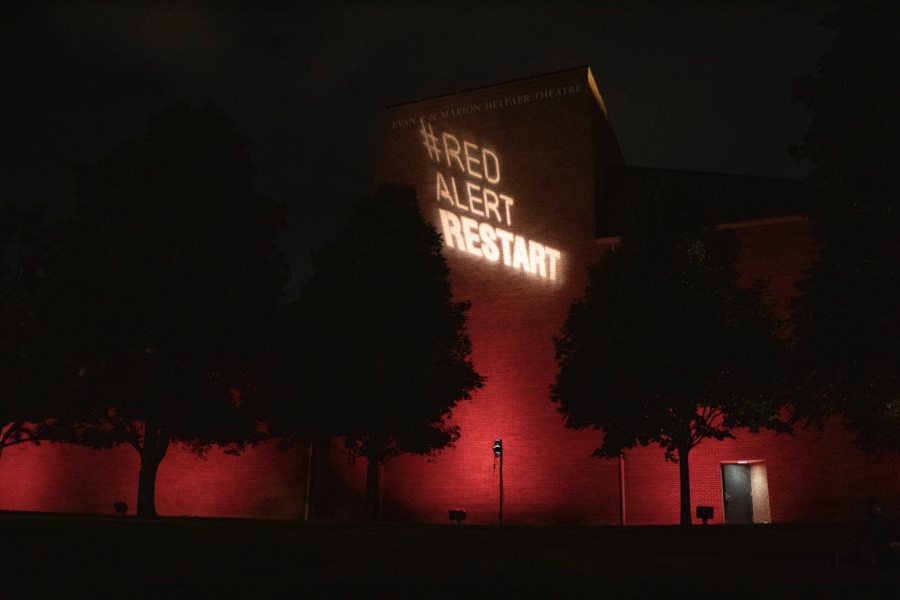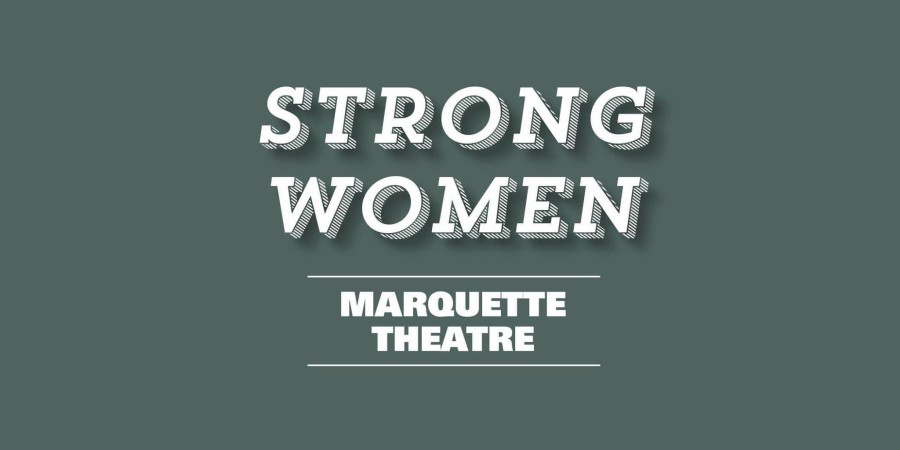One of theatre’s greatest strengths — and greatest challenges — is building a world through physical, tangible, hand-crafted and meticulously designed scenery and props. But what if scenes could switch location in an instant? What if the stage never has to go dark allowing dozens of bustling hands to transform a throne room into a dungeon, or a city street into a bedroom?
Chester Loeffler-Bell, artistic assistant professor of digital media and theatre arts in the College of Communication, along with John LaDisa, associate professor in the College of Engineering and director of the visualization lab, has been asking— and answering— these questions for the past couple years.
Utilizing the Engineering Hall’s Visualization Lab (which has been officially dubbed MARVL, though frequent users prefer simply calling it the VisLab), Loeffler-Bell and LaDisa produced a series of productions that blur the lines between theatre and film. Debuting this Friday, and running through the weekend, “RnJ” is his latest VisLab project: an unrehearsed, drastically abridged, comedic three-character take on Shakespeare’s classic romance-tragedy “Romeo and Juliet.”
The show will be performed by various local theatre groups Friday April 15 and Saturday April 16 at 6 p.m. and 8 p.m., while Marquette faculty members will take the stage Sunday April 17 at 6 p.m. followed by student performers at 8 p.m. Tickets are $10 to the public and $5 for Marquette students, faculty and alumni, and are being sold at the door and online.
Faculty performers include Ana Garner, interim dean in the College of Communication, Kristina Ropella, interim dean in the College of Engineering and Stephen Hudson-Mairet, associate professor and chair of digital media and performing arts in the College of Communication.
“(LaDisa) got his dean (Ropella), and that dean roped in our dean (Garner), who then got the last one (Hudson-Mairet) to do it,” Loeffler-Bell said. “Anna (Garner) is fired up to do it. They were all game.”
The VisLab features high-resolution rear projection and 3D capabilities, allowing for immersive and realistic environment creation. The $1.5 million room was created primarily with the engineering school in mind, though Loeffler-Bell jumped at the creative storytelling potential.
“I’ve been doing projects with Professor John LaDisa over in the VisLab the last two years, and what we’re trying to do is explore different avenues of how to use the VisLab,” Loeffler-Bell said. “With ‘RnJ,’ we wanted to reach out to the community and invite local groups to come in and see how it works.”
The pair used the VisLab to create hyper-realistic sets, producing two previous shows in the past two years exploring the unique possibilities the space provides.
Their first show “The Zoo Story” introduced them to the potential of live performances in the VisLab, while in the second, “Bald Soprano,” they took a leap in an entirely new direction— or more accurately, dimension.
“We’re not doing 3D for ‘RnJ,’ but we did for ‘Bald Soprano,'” Loeffler-Bell said. The scenery was projected, and the audience wore 3D glasses, like for a 3D movie. The scenery became 3D, but with live actors. It’s kind of a new experience; It was really cool.”
For the first show, Loeffler-Bell and LaDisa brought in local talents, while in the latter, Marquette students took the initiative. For “RnJ,” both local artists and students are helping to get the show off the ground.
Loeffler-Bell employed 2015 Marquette theatre arts alum Hannah Klapperich-Mueller and local theatre artist and educator Gracie Lee to act as project managers. Lee directed “The Zoo Story,” and wrote the first draft for “RnJ.” Mueller acted in “Bald Soprano,” and was tasked with community outreach and promotion for “RnJ.” Mueller will also be performing “RnJ” as a member of local theatre group Summit Players.
On the student side, Katie Hauger, a senior in the College of Communication, designed the scenery, while Chris Larkee, VisLab Technology specialist and B.F.A., turned the sets into a virtual reality.
“The whole thing has been a very collaborative project,” Mueller said. “We’ve had a very ‘we’ll see, figure it out as we go’ mentality, because it’s an unrehearsed project and not a traditional theater piece. It’s all been very different. We’re using the VisLab to create hyper-realistic sets that you can’t get in a theater. So in that way, it’s like actors are acting in a film, but are still in front of you, and has all the appeal of live theatre. It crosses some weird boundaries that don’t usually exist.”
While the VisLab certainly makes “RnJ” unique, the show’s unrehearsed nature is also a twist on the traditional theatre experience.
“One of the coolest things about this particular project is that because it’s unrehearsed, each performance will be different, and every show will be done by a different community group,” Mueller said.
Lee, who wrote the script, turned the Bard’s famous soliloquy-soaked tragi-romance into an extemporaneous, unrehearsed on-stage romp.
“(The actors) have had their words for a little while, so they can look up what the 400-year-old language means, but they don’t know what the other actors are going to say, outside of a few cues,” Lee said. “It’s become kind of an improv game for the actors out of what Shakespeare wrote 400 years ago.”

